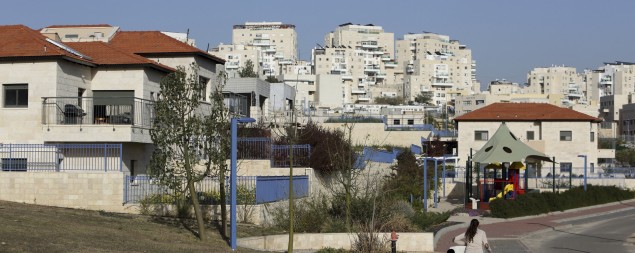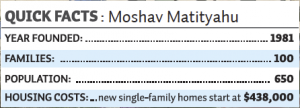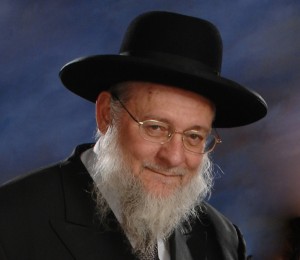A Chareidi Zionist Moshav: Moshav Matityahu

Street view of Moshav Matityahu. The moshav is located between Modi’in Illit and Hashmonaim ideologically as well as geographically. Photo: Flash 90
It is easy to overlook Moshav Matityahu. It is located on a strategic hill that overlooks Ben-Gurion Airport, across the road from Hashmonaim, a Modern Orthodox suburb that is popular among American olim. One reaches Matityahu from the road to Kiryat Sefer, the first neighborhood in the Chareidi city of Modi’in Illit. Considering that Matityahu’s population of about a hundred families is dwarfed by Modi’in Illit’s population of over 60,000, one can be forgiven for assuming it is a neighborhood of that large and rapidly growing city. Yet Matityahu has its own unique history and character. It is located between Modi’in Illit and Hashmonaim ideologically as well as geographically. In fact, when Modi’in Illit recently tried to annex Matityahu into its municipality, the courts ruled against the merger, partially on the grounds that Matityahu’s population would not fit well with the almost entirely Chareidi population of Modi’in Illit.
In 1978, a group of American Jewish families formed the nucleus of a Torah community they wished to build in Israel. They first moved to the community of Mevo Horon to learn the skills necessary to work the land and operate a moshav, or a collective farm, and the first twenty families moved to Matityahu in the summer of 1981. The fledgling moshav was affiliated with Po’alei Agudat Yisrael (PAI), a now-defunct political party and social movement for working Chareidim. During those first years—before they had telephones or a hookup to the national electrical grid, and before it had rained enough to fill up Matityahu’s mikvah—they received assistance from other PAI communities, especially Mevo Horon, with its two telephones, mikvah and small grocery store.
The moshav has undergone numerous changes since its founding. The original members were English-speaking olim who moved to Israel in order to work the land and lead lives infused with Torah. Like several other PAI communities, they were unabashedly Zionistic, celebrating Yom Ha’atzmaut with the recitation of Hallel. This attitude was in keeping with the rulings of Matityahu’s first rabbi, Rabbi Yehuda Herzl Henkin, a renowned posek, grandson of Rabbi Yosef Eliyahu Henkin, husband of Rabbanit Chana Henkin (see Jewish Action’s “Anglos Who Have Had an Impact,” spring 2014 issue), and father of Rabbi Eitam Henkin, Hy”d.
Rabbi Henkin left the moshav after a year and in the fall of 1983, Matityahu installed Rabbi Zev Leff as its new rabbi, a position that he retains to this day. Rabbi Leff left his pulpit at the Young Israel of Greater Miami to become the rav of a fledgling community with one-tenth the number of families. (A former NCSYer, Rabbi Leff is also the founding member of NCSY’s Miami chapter and served as chapter president from 1964 to 1965.) An alumnus of the Telshe Yeshiva in Cleveland, Rabbi Leff changed the community’s religious focus, bringing it more in line with Chareidi sensibilities and attracting more of a Yeshivish element. The community developed a unique Chareidi-Zionist blend during these years. One could see black hats along with knitted kippot (occasionally worn under the black hat). Hallel was no longer recited on Yom Ha’atzmaut, but the community marked the day with an annual softball game, in which Rabbi Leff served as designated pitcher for both teams. Some of the young men from Matityahu opted for extended full-time yeshivah study in lieu of military service, but most, following Rabbi Leff’s guidance, served in the IDF, whether for the full three years, in tandem with yeshivah study, or after several years in yeshivah.
Another major change occurred in the early 1990s, when the moshav privatized after a decade as a collective endeavor, and most members found jobs outside the community. These changes—Religious Zionist to Chareidi, and from collective endeavor to privatization—may seem fairly momentous, but Meir Migdal, one of the original members and the current chairman of Matityahu’s Management Committee, believes otherwise: “Collective ownership was never a function of ideology. It was what made sense at the time. Our main focus was always to build a Torah community in Eretz Yisrael. With all the changes and the bumps in the road, we have succeeded.”
 Matityahu has now entered a third phase of its existence. What was once frontier is now heartland. The nearby cities of Modi’in and Modi’in Illit, with a composite population approaching 200,000, have brought urban amenities and conveniences to Matityahu. It has become a destination for Israeli Chareidi families who want proximity to Modi’in Illit and its schools (virtually all residents of Matityahu send their children to schools in Modi’in Illit), but who still want to keep a bit of distance from it. In recent national elections, the single ballot box with the highest percentage of voters for United Torah Judaism (the Ashkenazic Chareidi party) was the one on Matityahu, with 97 percent. It is increasingly uncommon for the young men of Matityahu to join the IDF in any form, and fewer olim view Matityahu as a destination. New houses are being built, and some of the new residents are seeking to integrate into Matityahu’s community, but others are creating their own new community there. For the first time in its history, Matityahu now has two synagogues. The vast majority of adults, men and women, work for a living, but Yom Ha’atzmaut is no longer publicly celebrated.
Matityahu has now entered a third phase of its existence. What was once frontier is now heartland. The nearby cities of Modi’in and Modi’in Illit, with a composite population approaching 200,000, have brought urban amenities and conveniences to Matityahu. It has become a destination for Israeli Chareidi families who want proximity to Modi’in Illit and its schools (virtually all residents of Matityahu send their children to schools in Modi’in Illit), but who still want to keep a bit of distance from it. In recent national elections, the single ballot box with the highest percentage of voters for United Torah Judaism (the Ashkenazic Chareidi party) was the one on Matityahu, with 97 percent. It is increasingly uncommon for the young men of Matityahu to join the IDF in any form, and fewer olim view Matityahu as a destination. New houses are being built, and some of the new residents are seeking to integrate into Matityahu’s community, but others are creating their own new community there. For the first time in its history, Matityahu now has two synagogues. The vast majority of adults, men and women, work for a living, but Yom Ha’atzmaut is no longer publicly celebrated.
Today, Matityahu has two distinct populations. There are the old-timers—the English-speaking founders who by now are largely empty-nesters—and the younger population, which is growing rapidly, tends to be more Israeli and mainstream Chareidi, and has no memory of those first hard years. Still, the two populations get along well, aided by friction-limiting age differences, and many of the newcomers are still attracted to the sense of community and to Rabbi Leff’s leadership. The future is somewhat uncertain, but Matityahu has successfully reinvented itself before. Odds are that it will do so again.
Rabbi Elli Fischer is a writer and translator living in Modi’in.

